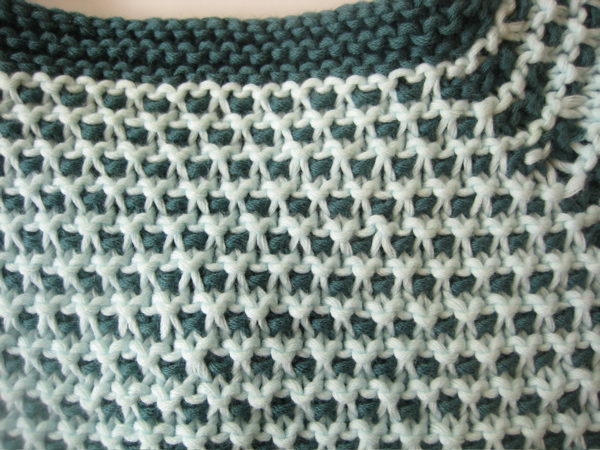 |
| Waffle stitch in two colors (yarn: Blue Sky Alpacas Skinny Dyed cotton) |
Knitters have always used simple combinations of knit and purl stitches to add texture, beauty, and provenance to their work. Add in a yarn-over or a slipped stitch, increases and decreases, and a truly spectacular library of fascinating stitch patterns become possible.
Want to try your hand at a fancy stitch pattern? Now's the time! I'm going to lay out a few basics here, and then over the next few weeks I'll be sharing some of my favorite stitch patterns with you, with lots of photo's and step-by-step how-to's.
First, a little myth-busting:
Myth: Fancy stitch patterns are hard to knit.
Fact: You already know everything you need to! You know how to make a knit stitch, right? You can make a purl stitch? Okay, you're all set! There are literally thousands of stitch patterns based on combinations of just these two stitches.
Myth: Knitting fancy stitch patterns requires too much concentration. I won't be able to binge-watch Orange is the New Black while working on my project.
Fact: Nobody wants to interfere with your You Time, so please, don't try complicated lacework when your brain is elsewhere. But many many stitch patterns are actually quite simple. Once you've repeated K3 P1 five times, it's stuck in your brain forever, and you're free to get sucked into the viewing experience of your choice.
Myth: You can't use fancy stitch patterns for knitting top-down sweaters, and that's my favorite kind.
Fact: Uh-huh! Just about any stitch pattern can be easily adapted to the top-down technique. In fact, I wrote a whole blog post about that once with step-by-step instructions. Check it out!
If there are still any doubts in your mind about trying out some stitch patterns, please share them in the comments section so that I may obliterate them! Cast your inhibitions aside and get going. Here are a few tips:
- Work loose stitches. I know this is easier said than done, especially for newer knitters who tend to knit more tightly. But stitch patterns often rely on twisting, slipping and otherwise manipulating your stitches after you've made them. Leave room for the fun by relaxing and knitting looser stitches.
- Practice the stitch pattern before you start the project. The best time to do this is when you're gauge-swatching. (YOU ARE GAUGE-SWATCHING. NO ARGUMENTS!). Work a few extra rows so that you start to get it memorized. When you start your project, you'll have it right from the start.
- Check your work against a photo. If your pattern doesn't have a clear photo of the stitch pattern, do a Google Image search to see how it's supposed to look. Sometimes the instructions aren't incredibly clear, and comparing what you've done to a good photo can help you get it right.
Ready to get started? A little added texture is a great way to show off the depth of colors in hand-dyed yarns, or to make a plain pullover suddenly elegant and far more fun to knit. Challenge yourself just a little - you'll be amazed at how much more sophisticated your knitting can become.

No comments:
Post a Comment
Note: Only a member of this blog may post a comment.